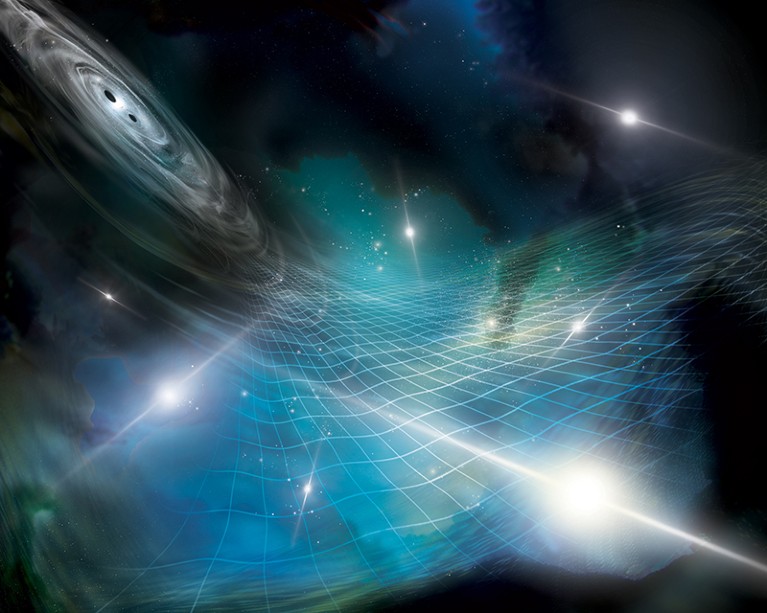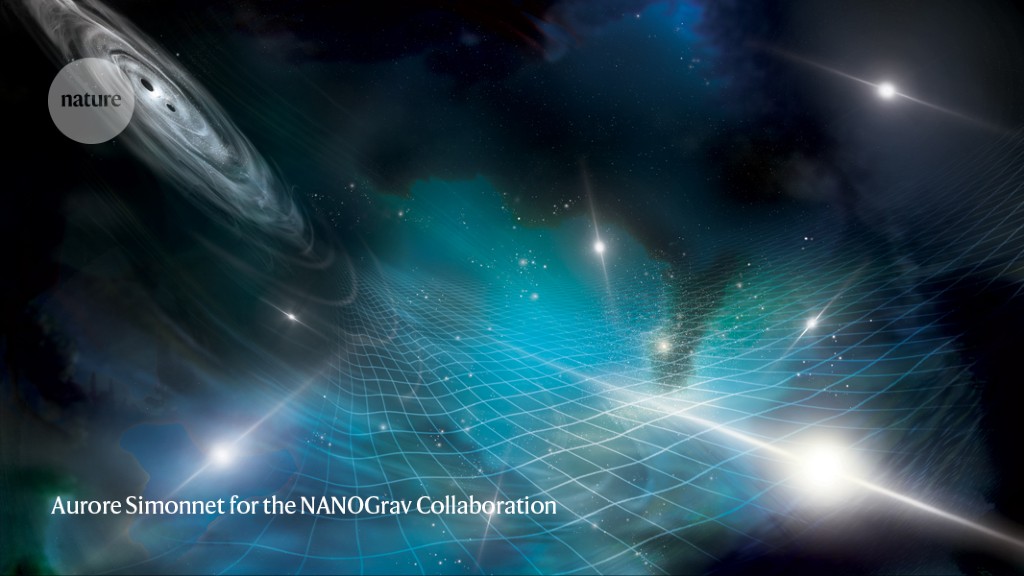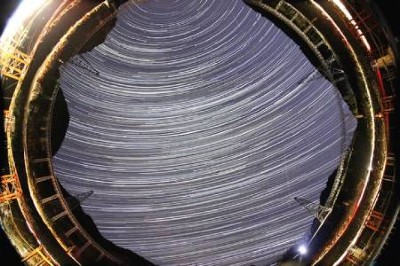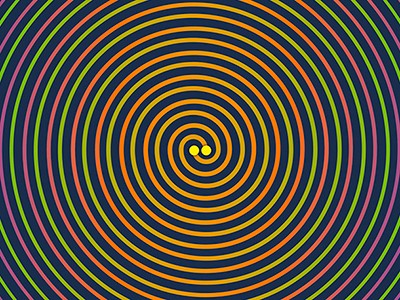
The collision of two supermassive block holes emits gravitational waves on this artist’s illustration.Credit score: Aurore Simonnet for the NANOGrav Collaboration
On 29 June, 4 separate groups of scientists made an announcement1–4 that guarantees to shake up astrophysics: that they had seen robust hints of very lengthy gravitational waves warping the Galaxy.
Gravitational waves are ripples within the material of space-time which might be generated when massive lots speed up. They have been first detected in 2015, however the newest proof hints at ‘monster’ ripples with wavelengths of 0.3 parsecs (1 mild 12 months) or extra; the waves detected till now have wavelengths of tens to a whole lot of kilometres.
<script type=”text/javascript”> atOptions = { ‘key’ : ‘015c8be4e71a4865c4e9bcc7727c80de’, ‘format’ : ‘iframe’, ‘height’ : 60, ‘width’ : 468, ‘params’ : {} }; document.write(‘<scr’ + ‘ipt type=”text/javascript” src=”//animosityknockedgorgeous.com/015c8be4e71a4865c4e9bcc7727c80de/invoke.js”></scr’ + ‘ipt>’); </script><\/p>
Right here Nature studies what these monster gravitational waves may imply for our understanding of the cosmos, and the way the sphere may evolve.
How do the newly introduced gravitational waves differ from these astronomers had already discovered?
Gravitational waves have been first noticed by the dual detectors of the Laser Interferometer Gravitational-Wave Observatory (LIGO) in Louisiana and Washington State. They sensed the ripples produced by two black holes spiralling into one another and merging. LIGO and its counterpart Virgo in Europe have since reported dozens of comparable occasions.
For the most recent outcomes, the authors relied on particular beacon stars known as millisecond pulsars. The groups tracked modifications over greater than a decade within the distances between Earth and millisecond pulsars within the Milky Manner, evaluating the indicators from arrays of dozens of the beacon stars. These pulsar timing arrays (PTAs) are delicate to waves which might be 0.3 parsecs lengthy or extra.
And whereas LIGO and Virgo spot proof of the final levels of particular person merger occasions — commonly spaced waves coming from one particular route within the sky — the 4 PTA collaborations have thus far discovered solely a ‘stochastic background’, a relentless jostling in random instructions. That is corresponding to the random sloshing of water on the floor of a pond brought on by the rain.
What’s the origin of the waves?
The almost definitely rationalization for the stochastic background seen by PTAs is that it’s produced by many pairs of supermassive black holes orbiting one another within the hearts of distant galaxies, says Sarah Burke-Spolaor, an astrophysicist at West Virginia College in Morgantown.
Most galaxies are thought to harbour one such monster black gap, with a mass tens of millions or billions of instances that of the Solar. And astronomers know that all through the Universe’s historical past, many galaxies have merged. So, some galaxies should have ended up with two supermassive black holes, often known as a black-hole binary.
Monster gravitational waves noticed for first time
Researchers even have calculated that within the crowded centre of such a galactic merger, every black gap would switch a few of its momentum to surrounding stars, slinging them out at excessive pace or just dragging them round. In consequence, the 2 black holes would ultimately decelerate and find yourself orbiting one another at distances of round 1 parsec, explains Chiara Mingarelli, a gravitational-wave astrophysicist at Yale College in New Haven, Connecticut.
Solely paired black holes that acquired a lot nearer to one another than 1 parsec would contribute to the PTA sign, nevertheless. “They should be separated by a milliparsec to emit detectable gravitational waves,” says Mingarelli. Theories that designate how this might occur are speculative, nevertheless, and whether or not the binaries can do that has been an open query, often known as the final-parsec downside. “For those who don’t overcome the final-parsec downside, then you definately don’t get any gravitational waves,” says Mingarelli.
Scientists will now search to confirm that the PTA sign does certainly come from binary supermassive black holes. If that might be confirmed, it will be proof that supermassive black holes can come very shut to one another in nature.
That outcome could be of elementary significance, says Monica Colpi, an astrophysicist on the College of Milan-Bicocca in Italy — exhibiting that hundreds of black-hole binaries throughout the Universe have one way or the other ‘solved’ the final-parsec downside. “It will be the invention that such a inhabitants exists.”
What would such binary black holes imply for LISA, Europe’s deliberate space-based detector?
Supermassive-black-hole pairs that acquired shut sufficient to emit gravitational waves would ultimately collide and merge. That’s as a result of the gravitational waves themselves would carry vitality and momentum away from the black holes, turning their orbits into spirals. In a whole lot to tens of hundreds of years, every of the pairs would find yourself colliding.
How gravitational waves may remedy a few of the Universe’s deepest mysteries
Colpi says this might be excellent news for the Laser Interferometer House Antenna (LISA), a trio of probes the European House Company plans to launch within the mid-2030s.
Because the black holes spiral inwards, the frequencies of their gravitational waves will enhance and, in some circumstances, enter LISA’s spectrum of sensitivity. LISA might be delicate to wavelengths of between 3 million km and three billion km — shorter than the wavelengths that may be detected by the PTAs, though nonetheless for much longer than these seen by ground-based detectors. So LISA may see a number of of those mergers throughout its mission.
Black-hole mergers may additionally assist to clarify how a few of the black holes have grown so massive: they’re themselves the results of earlier mergers.
Might one thing apart from binary black holes be producing the stochastic background?
There’s a plethora of exotic-physics theories that predict an analogous omnidirectional background of waves coming from all instructions in area. These sources may represent half and even many of the sign. The chances embody sure sorts of darkish matter and even cosmic strings, hypothetical infinitesimally skinny defects within the curvature of space-time. Cosmic strings may develop kinks, which may ultimately snap, producing gravitational waves.
One of the thrilling various explanations is a cosmic gravitational-wave background originating from the early Universe, says Burke-Spolaor. Telescopes that see throughout the electromagnetic spectrum — from radio waves to γ-rays — are restricted in how distant they will peek, and thus in how far into the previous they will see. It’s because, lengthy earlier than galaxies and stars existed, an opaque ionized gasoline crammed the cosmos. This blocks astronomers’ view of what occurred within the Universe throughout its first 400,000 years or so.
However gravitational waves can journey throughout any medium. In consequence, any such waves created for the reason that first prompt after the Huge Bang may nonetheless be round and be detectable as a part of a stochastic background, offering a window into the intense physics of the Huge Bang. “That’s simply superb to me,” says Burke-Spolaor. “Who is aware of what’s again there.”


